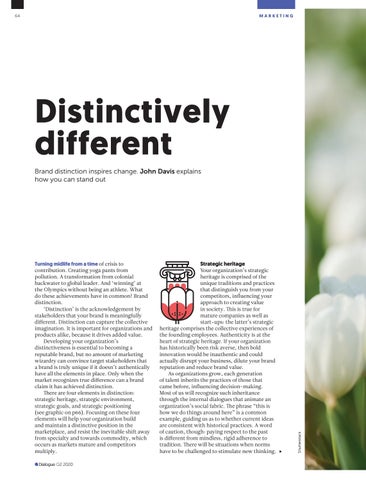MARKETING
64
Distinctively different Brand distinction inspires change. John Davis explains how you can stand out
Dialogue Q2 2020
Strategic heritage
Your organization’s strategic heritage is comprised of the unique traditions and practices that distinguish you from your competitors, influencing your approach to creating value in society. This is true for mature companies as well as start-ups: the latter’s strategic heritage comprises the collective experiences of the founding employees. Authenticity is at the heart of strategic heritage. If your organization has historically been risk averse, then bold innovation would be inauthentic and could actually disrupt your business, dilute your brand reputation and reduce brand value. As organizations grow, each generation of talent inherits the practices of those that came before, influencing decision-making. Most of us will recognize such inheritance through the internal dialogues that animate an organization’s social fabric. The phrase “this is how we do things around here” is a common example, guiding us as to whether current ideas are consistent with historical practices. A word of caution, though: paying respect to the past is different from mindless, rigid adherence to tradition. There will be situations when norms have to be challenged to stimulate new thinking.
Shutterstock
Turning midlife from a time of crisis to contribution. Creating yoga pants from pollution. A transformation from colonial backwater to global leader. And ‘winning’ at the Olympics without being an athlete. What do these achievements have in common? Brand distinction. ‘Distinction’ is the acknowledgement by stakeholders that your brand is meaningfully different. Distinction can capture the collective imagination. It is important for organizations and products alike, because it drives added value. Developing your organization’s distinctiveness is essential to becoming a reputable brand, but no amount of marketing wizardry can convince target stakeholders that a brand is truly unique if it doesn’t authentically have all the elements in place. Only when the market recognizes true difference can a brand claim it has achieved distinction. There are four elements in distinction: strategic heritage, strategic environment, strategic goals, and strategic positioning (see graphic on p66). Focusing on these four elements will help your organization build and maintain a distinctive position in the marketplace, and resist the inevitable shift away from specialty and towards commodity, which occurs as markets mature and competitors multiply.
